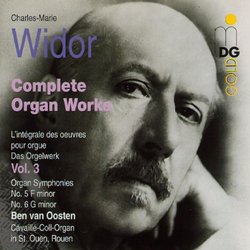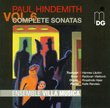| All Artists: Charles-Marie Widor, Ben van Oosten Title: Widor: Complete Organ Works, Vol. 3 Members Wishing: 0 Total Copies: 0 Label: MD&G Records Release Date: 11/14/1995 Genre: Classical Styles: Chamber Music, Historical Periods, Classical (c.1770-1830), Symphonies Number of Discs: 1 SwapaCD Credits: 1 UPC: 760623040325 |
Search - Charles-Marie Widor, Ben van Oosten :: Widor: Complete Organ Works, Vol. 3
 | Charles-Marie Widor, Ben van Oosten Widor: Complete Organ Works, Vol. 3 Genre: Classical
This third volume of the complete Widor organ music contains the Fifth and Sixth Symphonies--certainly the two most popular of Widor's organ compositions. In fact, in the concluding Toccata of the Fifth Symphony, we are de... more » |
Larger Image |
CD DetailsSynopsis
Amazon.com This third volume of the complete Widor organ music contains the Fifth and Sixth Symphonies--certainly the two most popular of Widor's organ compositions. In fact, in the concluding Toccata of the Fifth Symphony, we are dealing with the most popular single piece of organ music since the Toccata and Fugue in D minor of Bach. Academics love to sneer at Widor's Toccata as a tacky potboiler of a piece. It features an incredibly catchy tune that repeats itself to the point that you can't get it out of your head, and if it drives the official arbiters of taste insane, then that's their problem. The rest of us can simply enjoy it as the vivacious conclusion to a gorgeous piece of music. If you think that Widor is all flash, check out the haunting second movement. --David Hurwitz Similar CDs
|
CD ReviewsWidor, Complete Organ Works, Vol. 3 11/27/2002 (5 out of 5 stars) "Those that know Widor's organ music will find this recording authentic because ... it was recorded on a Cavaille-Coll instrument - very much the same instrument that Widor himself played and composed for. Secondly, Van Oosten's registrations are accurate - choosing registrations simlar to those of Widor himself. If you like bright sounding organ registrations .... stick with the composers of the baroque period. Composers of the romantic literature period pursued color more than brightness. Lastly ...... his interpretations are accurate. What better combination can a Widor organ music fan ask for? An accomplished organist playing the complete cycle of Widor symphonies in an authentic way that pays value to the intent of the composer himself. If that's what you're after .... you will be pleased with Mr. Van Oosten." Emotional Paydirt Avid Reader | Franklin, Tn | 07/29/2003 (5 out of 5 stars) "We have finally arrived at the pinnacle of Widor's Romantic era, the period in which he composed Symphonies 4-8. The fifth is the most popular, due in large part to the grandeur of the opening. The sounds emanating from this instrument (similar to one used by Widor himself) are just incredible and exploit the new effects of the "French" organ perfectly. But the Sixth Symphony has its many fans and is, in many ways, a superior work as a whole. The "breathing" from the pipes is particularly highlighted in this piece. The syncopation is just perfect. Some have opined that these piece seem a tad slow or leaden but van Oosten's interpretation is, I think, the correct one. Widor was aiming for denseness - not an ethereal lightness. One can easily grasp the overall sense of solemnity within these works that I am sure was the intent of the composer" Superb playing by Ben van Oosten Robert M. van Zoelen | the Netherlands | 12/06/2000 (5 out of 5 stars) "In my opinion, this is the current recording standard for Widor's organ works. Not only has Ben van Oosten selected magnificent instruments for this recording -and the other ones in the series as well. His interpretation of both Symphonies 5 & 6 is fascinating, Widor has a story to tell and Ben van Oosten is an ideal organist to bring this story back to life. Never dull, well balanced, technically refined. A must for those people that love French organ music."
|

 Track Listings (10) - Disc #1
Track Listings (10) - Disc #1
